The Importance of Pilot Lamps in Modern Technology
Have you ever been in a situation where you're using a device or operating a system, and you're not quite sure if it's on or off, running or stopped, or in a specific mode? It can be frustrating and even dangerous if you're not sure what the device is doing. That's where pilot lamps come in. These small but powerful components provide a clear and easy way to understand the status and operation of various devices and systems. In this era of modern technology, pilot lamps continue to play a crucial role in providing visual feedback to users, improving safety, efficiency, and ease of use.
What is the Pilot Lamp?
Pilot lamps, also known as indicator lamps or signal lamps, are small lights used to indicate the status or operation of a device or system. They are typically used in control panels, electrical equipment, and appliances to provide visual feedback to the user.
Pilot lamps can come in a variety of colors, such as red, green, yellow, and blue, and can be either LED-based or incandescent. They are often used in conjunction with switches, buttons, or other controls to show whether a device is on, off, or in a particular mode.
For example, a pilot lamp may be used in a coffee maker to indicate that the machine is on and heating up, or in a car to indicate that the headlights are on. In industrial settings, pilot lamps may be used to indicate the status of a machine or process, such as whether it is running, stopped, or in need of maintenance.
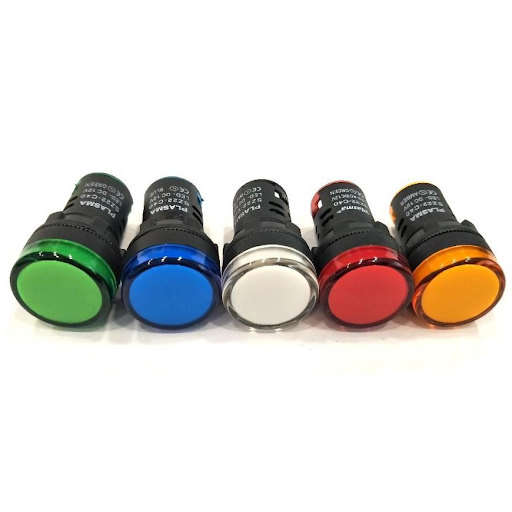
Fig 1. Pilot lamps
Pilot Lamp Function
The primary function of a pilot lamp is to provide visual feedback to users about the status and operation of various devices and systems. They typically consist of a small light source, such as an LED or incandescent bulb, housed in a colored lens or cover.
When a device or system is turned on or in operation, the pilot lamp is illuminated, providing a clear indication of the device's status. For example, a pilot lamp may indicate whether a machine is running or stopped, whether an appliance is in use or off, or whether a system is in a specific mode.
Pilot lamps can help improve safety by providing a clear indication of the status of devices and systems, such as whether a machine is running or stopped, or whether a system is in a hazardous condition. They can also help reduce energy consumption by providing a clear indication of when devices and systems are on or off, allowing users to turn them off when not in use.
What are the Types of Pilot Lamp?
Several types of pilot lamps are commonly used, including:
Incandescent Lamps
Incandescent lamps, also known as incandescent light bulbs, are a type of electric lamp that produces light by heating a filament wire to a high temperature until it glows with visible light. They were the most common type of electric light bulb until recently, when more energy-efficient options like LED lights have become more popular.
The filament wire in an incandescent lamp is typically made of tungsten and is housed within a glass bulb filled with an inert gas, such as argon or nitrogen, to protect the filament from oxidation. When an electric current is passed through the filament, it heats up and emits light, producing a warm, yellowish glow.
Incandescent lamps come in a range of shapes, sizes, and wattages, and are used for a variety of applications, including residential lighting, decorative lighting, and industrial lighting. However, they are not very energy-efficient, as a significant amount of the energy they consume is given off as heat rather than light, and they have a relatively short lifespan compared to other types of bulbs.
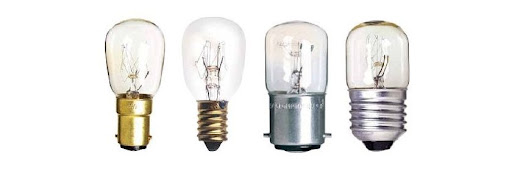
Fig 2. Incandescent pilot lamps
LED Lamps
LED stands for "Light Emitting Diode." LED lamps are a type of lighting technology that uses semiconductors to convert electricity into light. Unlike traditional incandescent bulbs, which generate light by heating a filament, LED lamps produce light through a process called electroluminescence.
In an LED lamp, an electrical current is passed through a semiconductor material, which emits light energy in the form of photons. The color of the light emitted by an LED depends on the composition of the semiconductor material, and can range from red and yellow to green, blue, and violet.
LED lamps are highly energy-efficient, using up to 80% less energy than traditional incandescent bulbs to produce the same amount of light. They also have a much longer lifespan, typically lasting 25,000 to 50,000 hours or more, compared to around 1,000 hours for an incandescent bulb. LED lamps are available in a range of shapes, sizes, and colors, and are used for a variety of applications, including residential lighting, commercial lighting, automotive lighting, and more.
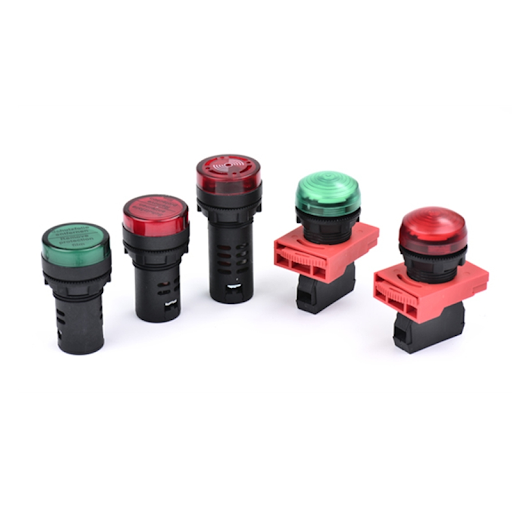
Fig 3. LED Pilot Lamp
Neon Lamps
Neon lamps are a type of gas discharge lamp that produces light through the ionization of neon gas. They were first developed in the early 20th century and have been used in a variety of applications, including advertising signs, displays, and decorative lighting.
In a neon lamp, a glass tube is filled with neon gas and a small amount of other gases, such as helium or argon. When a high voltage is applied across the electrodes at each end of the tube, it ionizes the gas, causing it to emit a bright, colorful light.
Neon lamps come in a variety of colors, including red, orange, yellow, green, blue, and purple, depending on the type and quantity of gases used in the tube. They are highly visible and have a distinctive, retro appearance that makes them popular for advertising and decoration.
Although neon lamps are not as energy-efficient as LED lamps, they can be highly durable and long-lasting, with a typical lifespan of 10,000 to 50,000 hours or more. They are also highly customizable, allowing for the creation of intricate designs and patterns.
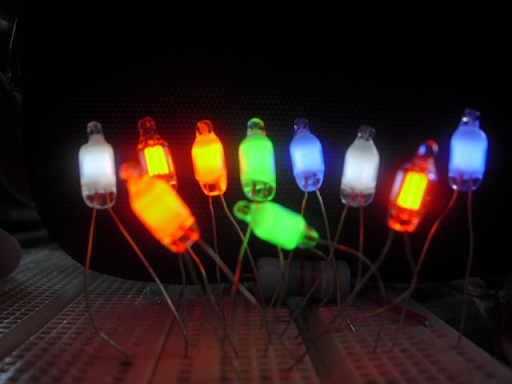
Fig 4. Neon pilot lamps
Halogen Lamps
Halogen lamps are a type of incandescent lamp that uses halogen gas to improve efficiency and increase lifespan. They work in a similar way to traditional incandescent lamps, but with a few key differences.
In a halogen lamp, a tungsten filament is housed within a small, quartz glass envelope filled with a halogen gas, such as iodine or bromine. When the lamp is turned on, the filament heats up and produces light, as in a traditional incandescent bulb. However, the halogen gas helps to redeposit evaporated tungsten back onto the filament, reducing the amount of light loss and prolonging the life of the bulb.
Halogen lamps have a number of advantages over traditional incandescent bulbs. They are more efficient, producing more light per watt of energy used, and they have a longer lifespan, typically lasting two to three times longer than traditional bulbs. They also provide a bright, clear light that is ideal for applications where color accuracy is important, such as in photography or art galleries.
However, halogen lamps also have some disadvantages. They can get very hot, so they need to be handled with care to avoid burns or fires. They are also less energy-efficient than LED lamps, so they may not be the best choice for applications where energy savings are a top priority.

Fig 5. halogen pilot lamp
Indicating LEDs
Indicating LEDs, also known as indicator lights, are small LED lamps used to provide visual feedback in electronic devices or systems. They are typically used to indicate the status of a device or system, such as power on or off, a fault condition, or a warning.
Indicating LEDs are available in a range of colors, including red, green, yellow, blue, and white, and can be designed to emit a continuous light or to flash at a specific rate. They are often mounted on a circuit board or panel and are wired to the device or system they are indicating.
Indicating LEDs are popular in a wide range of electronic applications, from consumer electronics to industrial control systems. They are reliable, long-lasting, and energy-efficient, making them an ideal choice for applications where low power consumption and high reliability are important. They are also available in a variety of shapes and sizes, including surface-mount, through-hole, and panel-mount configurations, making them easy to integrate into a wide range of designs.
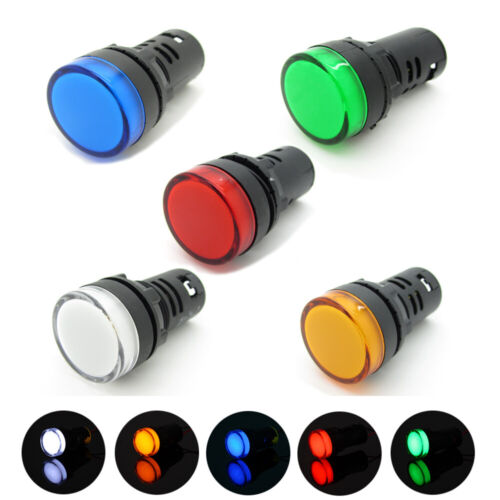
Fig 6. LED Indicator Pilot Light Signal Lamp
Pilot Lamp Applications

Fig 7. Pilot lamps are considered a type of control switch.
Pilot lamps are used in a wide range of applications to provide visual feedback to users. Some common applications of pilot lamps include:
- Control panels: Pilot lamps are often used in control panels to indicate the status of various devices and systems. For example, a pilot lamp may be used to indicate whether a motor is running or stopped, whether a machine is in operation, or whether a system is in a specific mode.
- Appliances: Pilot lamps are commonly used in household appliances such as ovens, coffee makers, and dishwashers to indicate whether the appliance is on, heating up, or in a specific mode.
- Automotive: Pilot lamps are widely used in cars and other vehicles to indicate the status of various systems, such as headlights, turn signals, and brake lights.
- Industrial machinery: Pilot lamps are used in industrial machinery to indicate the status of various machines and systems, such as whether they are running, stopped, or in need of maintenance.
- Medical equipment: Pilot lamps are used in medical equipment to indicate the status of various devices, such as whether a surgical light is on or off.
- Electronics: Pilot lamps are commonly used in electronic devices to indicate the status of various functions, such as battery charging or power on/off.
Pilot Lamp Advantages and Disadvantages

Fig 8. Pilot lamp
Advantages of Pilot Lamp
- Pilot lamps are an easy and effective way to provide visual feedback to users about the status and operation of various devices and systems.
- They are relatively inexpensive and easy to install in various applications.
- They come in a variety of colors and types, allowing for customization to specific needs and applications.
- They can help improve safety by providing clear indications of the status of devices and systems, such as whether a machine is running or stopped.
- They can help reduce energy consumption by providing a clear indication of when devices and systems are on or off.
Disadvantages of Pilot Lamp
- Pilot lamps consume power, even when they are not providing useful information to the user. This can add up to significant energy waste over time.
- They may not be visible in bright or direct sunlight or poorly lit environments, which can limit their effectiveness.
- In some cases, pilot lamps may provide insufficient information about the status of a system or device, such as when a more detailed display or indicator is needed.
- Some types of pilot lamps, such as incandescent bulbs, have a limited lifespan and require frequent replacement, which can be a maintenance and cost issue.
Conclusion
In conclusion, pilot lamps are small but important components used in a wide range of devices and systems to provide visual feedback to users about their status and operation. They can be found in various applications, such as control panels, appliances, automotive, industrial machinery, medical equipment, and electronics. While pilot lamps have some disadvantages, such as energy consumption and limited visibility in certain environments, their advantages, such as ease of installation, customization, and improved safety, make them a popular and effective option for providing visual feedback to users. Overall, pilot lamps play an important role in improving the safety, efficiency, and ease of use of various devices and systems.
To recap
Sure, here are some frequently asked questions about pilot lamps:
What is a pilot lamp?
A pilot lamp, also known as a signal lamp or indicator light, is a small lamp used to indicate the status of a device or system. It is typically used to provide visual feedback to the user, such as whether the device is on or off, whether a fault condition exists, or whether an action is required.
What are pilot lamps used for?
Pilot lamps are used to indicate the status and operation of various devices and systems. They can be found in a wide range of applications, including control panels, appliances, automotive, industrial machinery, medical equipment, and electronics.
How do pilot lamps work?
Pilot lamps typically consist of a small light source, such as an LED or incandescent bulb, housed in a colored lens or cover. When a device or system is turned on or in operation, the pilot lamp is illuminated, providing a clear indication of the device's status.
What are the different types of pilot lamps?
The different types of pilot lamps include LED lamps, incandescent lamps, neon lamps, and filament lamps. They come in a variety of colors, sizes, and shapes, allowing for customization to specific needs and applications.
What are the advantages of using pilot lamps?
The advantages of using pilot lamps include providing visual feedback on the status of devices and systems, improving safety, reducing energy consumption, and being relatively inexpensive and easy to install.
What are the disadvantages of using pilot lamps?
The disadvantages of using pilot lamps include consuming power even when not providing useful information, having limited visibility in certain environments, and requiring frequent replacement in some cases.
Can pilot lamps be customized?
Yes, pilot lamps can be customized in terms of color, size, shape, and lens or cover type, allowing for specific needs and applications.
Recent Posts
-
Booster Pump Troubleshooting and Maintenance: How to Fix and Prevent Common Issues
1. Introduction Imagine turning on your faucet only to be greeted with a weak trickle of water when …22nd Apr 2025 -
Energy-Efficient Booster Pumps: Selection and Tips for Maximizing Performance
1. Introduction Imagine never having to deal with fluctuating water pressure, noisy pumps, or skyroc …19th Apr 2025 -
Booster Pumps for Sustainable Water Systems: Irrigation and Rainwater Harvesting Solutions
1. Introduction Water scarcity is no longer a distant threat—it’s a reality affecting millions …16th Apr 2025




